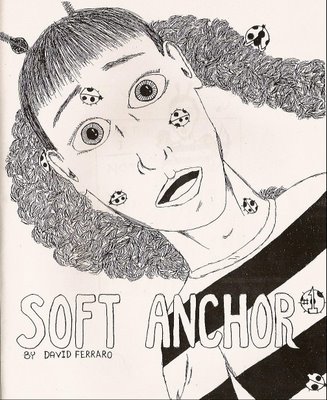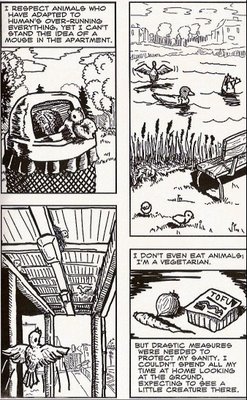Two Mini-Comics from Chris Davis Fish Out of Water
Fish Out of Water This oblong shaped mini-comic is read with the stapled spine facing upwards.
Fish Out of Water is more visual poetry than story. Davis uses ten, or eleven if you count the cover, images to tell the story of a fish snatched out of the water with a butterfly-baited hook.
As a reader, and because of the title, I focused on the plight of the fish, but the last page has a poem about the butterfly pierced by the hook. This made me revisit the cover and glance at the story from another perspective. On the cover the butterfly traces an arc through the sky; its trajectory is awkward rather than effortless – it’s on the end of the fishing hook, of course.

The first page of the comic focuses on the fish circling in the water, but this view is clearly from the vantage of the butterfly as it sinks to the water’s surface. On page two the butterfly breaks the surface of the pond with a very pronounced splash.
Here are the opening lines of the poem that ends the comic:
“Butterfly has a problem
a persistent wobble
a wandering bubble inside
and her steadiness is gone.”
Fish Out of Water is quiet and graceful. Contact Davis at squawkalong@yahoo.com and get your own copy for $1.50. Not to break the mood or anything, but Davis’ fish looked a lot like penises in this mini-comic. Hmmm.
CrawlingAs in
Fish Out of Water, the pages of
Crawling only have art on the one side. So rather than thirty pages
Crawling is fifteen pages. Each page is one panel consisting of an image and accompanying prose. The two characters in
Crawling begin as reptilian or devilish beings, the tiny male figure climbing up the back of his partner, stalking her femaleness. She’s coy, but he drags her off a cliff and into the ocean.

As they plunge deep into the ocean, the two figures regain their humanity and begin a struggle against nature and the forces that work to drive two individuals apart. The art moves from elegant and lithe to blunt and driving as the forces begin working on them.
Crawling is $2 and available by contacting Davis at squawkalong@yahoo.com
Neither of these minis are traditional story driven comics, but rather prose set to single images. That’s part of the charm of mini-comics; they can be more experimental and flexible. Sometimes it’s not so much the story you want to tell, but the feeling you want to communicate to the reader.
One small detail that I really liked was the tiny bird squawking next to Davis’ email address. Very cute.



















